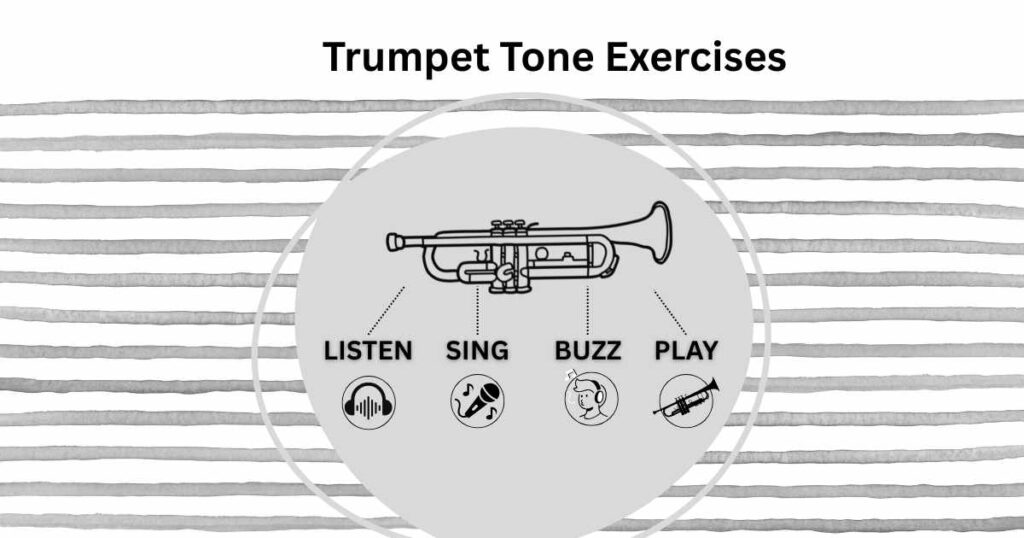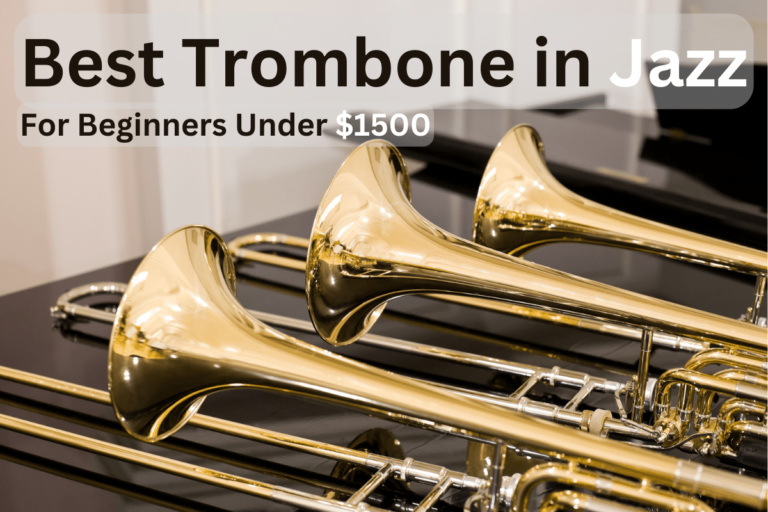5 Trumpet Tone Exercises PDF — Free Sheet Music + Pro Tips For Routines

Tone is everything for trumpeters! Solid trumpet tone exercises make your music pop and blend in a band!
A great tone isn’t just for solos or jazz bands. It’s your musical fingerprint! Good tone lets you express yourself, play with others, and enjoy every note!
Here’s what you’ll get in this guide:
- Simple routines.
- Free trumpet tone exercises in PDF
- Pro tips from real players (Reddit, Quora, and my own connections)
Get free PDF trumpet tone exercises right now! You can start practicing right now and level up your sound.
Trumpet Tone Exercises — The Foundation of Great Sound
Trumpet tone is all about how your sound comes out of the bell — not thin, not squeaky, but full and resonant. A lot of trumpet pros (like Vincent Cichowicz and Arnold Jacobs) talk about “singing through the horn”. That’s really it — imagine you’re singing, but using the trumpet instead.
A sweet trumpet tone is a mix of your embouchure (lips and tongue form), airflow, posture, and your mental “model” of sound.
“Long tones may arguably be the most beneficial thing to practice as you are just honing in on producing a full, steady, and beautiful trumpet sound.”
A few minutes spent on trumpet tone exercises will warm up your face muscles (and your fingers). It helps steady your airflow and center your tone.
When you play through, start with good posture. Stand tall, shoulders relaxed, trumpet up. Take a deep breath and play the first note. For more details, read my “Trumpeter 5 First Steps: How to Hold a Trumpet Like a Pro“.
Trumpet Tone Exercises #1
“Trumpet Tone Exercises 1” is the first in a six-part series. It helps if you miss the right note or mix up partials. For a newer trumpeter, this is a great place to begin, as it has no hard notes or fast changes.
This exercise was made — on purpose — with random intervals between the notes. That means your ear has to do more work — you can’t guess the next pitch by pattern alone. You have to hear the next note in your head first!
The goal isn’t just to play the note—it’s to imagine it first, then match it. That trains your brain and ear together.
Let’s break down how “Trumpet Tone Exercises 1” is set up:
- Key: Concert C major
- Time Signature: 4/4 “common time”
- Suggested tempo: ♩ = 60–72 bpm
The full exercise is 64 measures long, with rests to reset your breath. The harmony doesn’t really change — you’re staying in the key most of the time.
Hold each note for four beats, then move to the next note in the series.
The mood of the piece stays calm throughout. It encourages deep breathing and relaxed playing. Focus on embouchure consistency across different registers.
Trumpet Tone Exercises #2: C – Low F# – C
“Trumpet Tone Exercise 2” focuses on playing C – Low F# – C. I think that’s a really useful range for developing both middle and low register control. Use it as a warm-up or as a tone drill at the start of practice.
Here’s a quick look at the structure:
- Key: Concert C major
- Time Signature: 4/4
- Tempo: Slow, recommend ♩ = 60 BPM
The exercise cycles through C, low F#, then back up to C, teaching balance between registers. Use a tuner or drone note for reference to maintain pitch on the low F#.
Hold each note for four full measures, sustain the sound without stopping. There are no dynamic or articulation marks — play everything as smoothly and evenly as possible.
Use full breaths and avoid tension! Make this not just a tone drill, but a breathing and relaxation exercise as well. Keep the tempo slow.
Try playing “Trumpet Tone Exercise 2” one octave higher if the low F# is too challenging at first.
Trumpet Tone Exercises #3 — Trumpet Long Tones #1
“Trumpet Long Tones: Exercise #1” comes from a long tradition (I like to think of it as a “tried-and-true method”). For over 100 years (according to Ken Saul), brass players have warmed up using long tones.
This exercise is based on ideas from famous trumpeters such as J. B. Arban, Max Schlossberg, and Herbert L. Clarke.
Here’s a quick breakdown of the sheet music:
- Key: C major
- Time Signature: 4/4 (four beats per measure)
- Tempo: Slow, around♩ = 60 BPM
The exercise shows dynamic markings: “mf” (mezzo-forte) and “f” (forte), with crescendo (<) and decrescendo (>) symbols. Every dynamic shift happens gradually — NO sudden jumps! This helps you learn smooth air control.
You’ll also see breath marks (commas) to remind you when to take a breath. Each note follows the same process: play → swell → fade → breathe.
Hold notes for a long time while controlling breath and tone. This builds the “core sound” every trumpet player wants. Even professional players use long tones daily!
Trumpet Tone Exercises #4 — Trumpet Long Tones #2
In “Trumpet Long Tones: Exercises 2“, the goal is to play each note evenly and connect them with slurs.
Let’s break down how “Trumpet Long Tone Exercises 2”:
- Key: C major
- Time Signature: 4/4
- Tempo: ♩ (quarter note) = 60 bpm
You’ll notice little numbers under the notes — these show which valves to press. If you want to try alternate fingerings, check my “B Flat Trumpet Fingering Chart PDF + Beginners Sheet Music“.
Key symbols:
- (0) = open valves
- (1) = first valve
- (2) = second valve
- (3) = third valve
- Combinations like (1+2) or (1+3) show multiple valves pressed together.
Once you finish going down, you go back up the same way (E, F, F#, G). Later, it includes arpeggios (C-E-G) and some chromatic notes (C# or D#).
The harmony stays the whole time. There are no key changes or tricky accidentals. The melody moves stepwise with occasional skips. There are no complicated rhythms — everything is with a steady beat.
Trumpet Tone Exercises #5 — Edude
This “Trumpet Tone Etude” builds a beautiful, strong trumpet tone. It improves your sound quality, breath control, and embouchure strength.
Use it to work on holding long notes (“sustains”), making clean slurs, and playing with steady air. The exercise covers both low and mid trumpet registers, giving your lips a solid workout.
- Key: F major
- Time Signature: 4/4
- Tempo: ♩ (quarter note) = 120 bpm
The sheet music moves from simple to more complex patterns — stay focused on tone and accuracy! Near the end, the rhythms speed up with triplets and sixteenth notes. You’ll also need to tongue more here.
To get the best results, practice this etude every day, even five to ten minutes makes a difference. Always start slowly. Use a metronome to keep your tempo steady.
Recording yourself once a week can help you see your progress. Try playing long notes soft, then loud. Mark tricky fingerings right on the music.
Take breaks when your lips feel tired, and (most of all) be patient with yourself.

Expert Insights — What the Pros Say About Trumpet Tone Exercises
Most folks say you gotta start with long tones — just holding out notes, soft to loud, then back to soft. The middle of your range is the sweet spot. Don’t chase those super high notes right away!
Some players push themselves with “extreme” long tone routines. But even the hardcore crowd says don’t go overboard. If you skip a day, don’t try to make up for it all at once. Rest is just as important as practice.
Teachers and advanced players love the “Listen-Sing-Buzz-Play” approach. You listen to a trumpet sound, sing it, buzz it on your mouthpiece, then play it on your horn. This routine is a triple threat — it trains your ear, builds muscle memory, and helps you lock in a clear, PRO tone.
One other thing — listening is huge! Find a player you love, keep that sound in your head, and try to copy it every time you play. Your brain will start to figure it out over time. Find your fav in “Top 11 Famous Trumpet Players That Will Instantly Inspire You“!
But let’s be honest — building a great tone takes patience. There’s no magic shortcut. The best advice I’ve seen is to keep things fresh, take breaks, and never force it when you’re tired. For every hour of playing, I’d say take at least a 10-minute break..
So, bottom line: go slow, listen a ton, buzz before you play, and never skip the basics (even if it feels boring). Your tone will get better, little by little (I promise, it’s worth it).
FAQs: Trumpet Tone Exercises and Practice Routines
How long should I practice tone exercises daily?
Most players recommend 5–10 minutes of focused long tones, but total practice can range from 20–60 minutes (with breaks). Quality beats quantity every time.
What if my tone isn’t improving?
Listen to great players, use the Listen-Sing-Buzz-Play method, and focus on relaxed, steady airflow. If you’re stuck, record yourself or ask for feedback.
Should I do long tones every day?
Yep! But don’t overdo it. Even pros take days off or swap in buzzing or flow studies to keep things fresh and avoid burnout.
What’s the best way to warm up for tone?
Start with air exercises, then lip buzzing, mouthpiece buzzing, and finally long tones. Keep everything relaxed and easy.
Conclusion — Trumpet Tone Exercises
Alright, let’s wrap it up. Trumpet tone exercises are the secret sauce to sounding pro. Listen to great players, sing and buzz before you play, and keep your routine relaxed and steady.
Download the free Trumpet Tone Exercise PDF. Use it daily, keep things chill, and watch your sound level up.
Remember: every day you play, you get a little closer to that killer tone you want. Keep at it, and let’s get those trumpets singin’!






